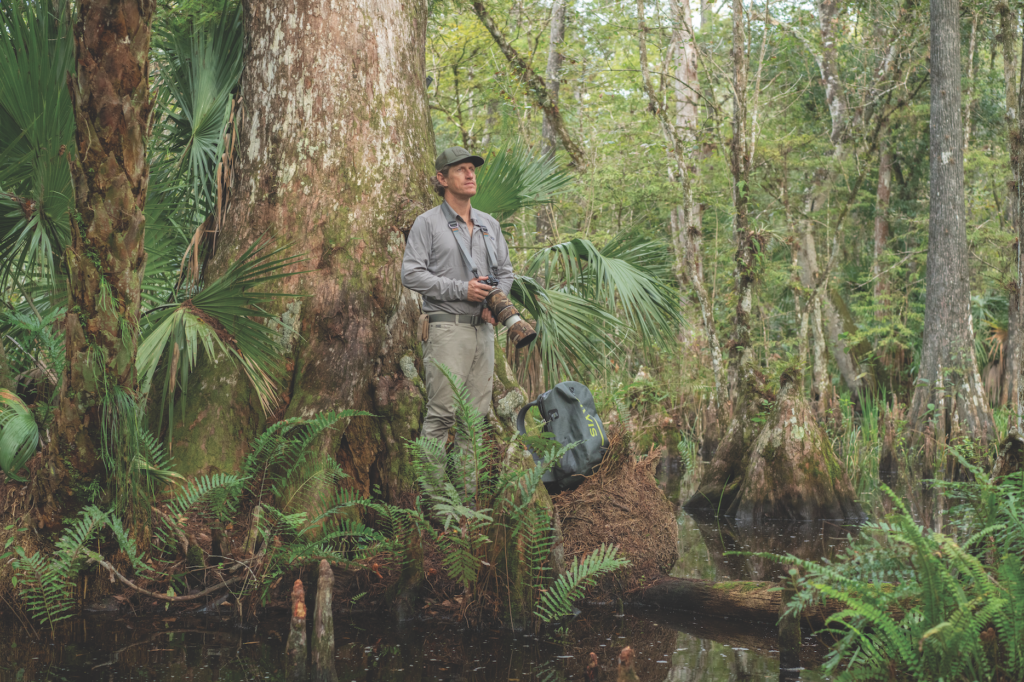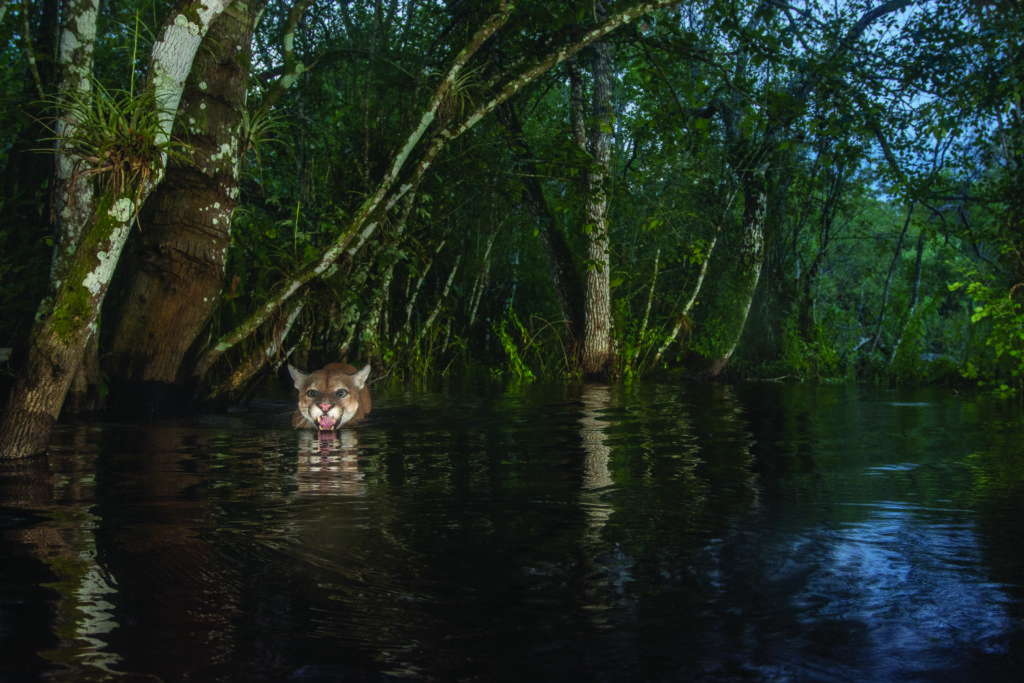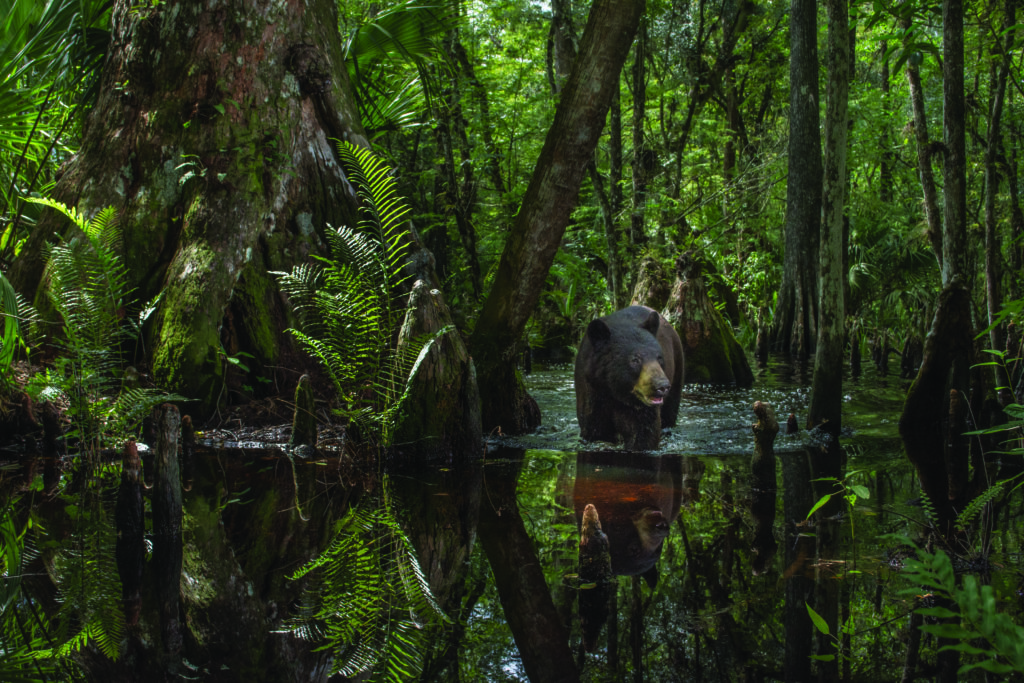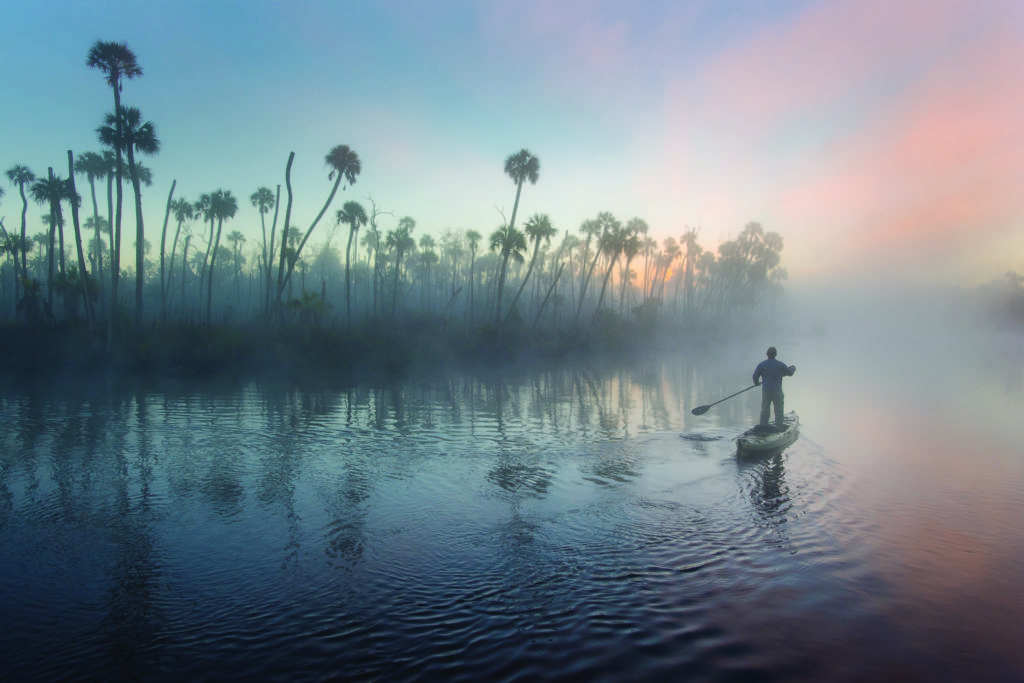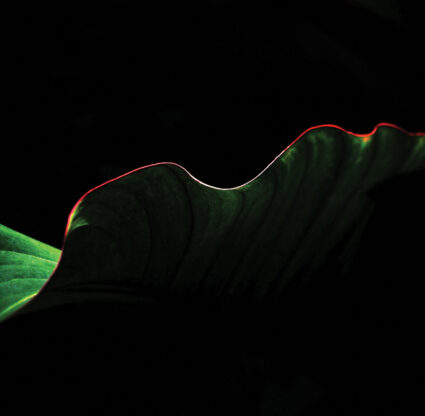The photo Carlton Ward Jr. worked for nearly two years to capture happened in the backcountry of Audubon’s Corkscrew Swamp Sanctuary along a tree-shaded path that dead-ends at a barbed-wire fence. I follow him to that spot on a crisp February afternoon. Across from us is a private ranch, as tranquil as the sanctuary. If not for the human-made boundary, the forested landscapes would blend as one. That’s the point, he explains. Ward, a conservation photographer, National Geographic Explorer and founder of the Florida Wildlife Corridor, wanted to document a Florida panther crossing between the ranch and Audubon’s land to deliver this message: We need undeveloped land—millions more acres of it, public and private alike—to ensure wildlife, like the Florida panther, survives.
“The camera was here,” he says, gesturing to where he rigged a camera trap. “And the panther would have stepped through right here.” He crouches as if channeling the cat. In April 2020, under graying skies, a female panther tripped Ward’s sensor. Click! Ward’s Nikon fired in its box, catching her midstep, her cub in tow. The image appeared in an April 2021 feature story in National Geographic—a personal coup for the 46-year-old photographer and an international spotlight for the endangered panther and its dependence on the Florida Wildlife Corridor, a cause that has consumed him for some 15 years.
That same month, the Florida legislature, which he’d armed with similar images and documentary-style videos, unanimously passed the Florida Wildlife Corridor Act. It formally defines a continuous 18-million-acre swath of habitat and endorses a conservation strategy environmentalists believe is the key to solving ecological woes like habitat loss. In tandem, lawmakers allocated $400 million to revive land-buying programs that were slashed during the Great Recession and never fully restored until now. State Sen. Kathleen Passidomo, a key advocate from Naples, expects another $300 million will be approved this year. “I think it’s one of the most significant endeavors we have undertaken in the last 50 years at least,” Passidomo tells me.
Storytelling was key. Ward, an eighth-generation Floridian compelled by a love for his state and a commitment to protect its wilderness, designed the narrative to inspire decision-makers. “The challenge now is to see if we can keep the investment going for the next decade and beyond,” he says.
The Corridor exists partly on paper, as a map suggesting what it could be, and partly in reality. Ten million acres, including Corkscrew, are already conserved in pieces throughout the state. Ward and fellow Corridor advocates are pushing to protect up to 8 million more to create a contiguous ecological channel from South Florida to the Georgia border and from the Atlantic coast to the Panhandle’s tip.
Finalizing the Corridor means managing growth, protecting water, defending agriculture, supporting tourism and blunting biodiversity loss—a problem many scientists warn is as serious as the climate crisis. “Recent studies suggest we need to be saving 10,000 acres a month in order to save critical parts of the Wildlife Corridor,” Ward says. Florida is on track to lose 5 million acres of land to development by 2070 at its current pace, according to the Florida 2070 study, which he often cites. “Ten thousand acres a month of conservation sounds like a lot, but it’s just reaching parity. That’s just to balance the development so you’re saving as much as you’re losing.”
Environmental discussions often halt with statistics like that. The problem appears too overwhelming. The Florida Wildlife Corridor strategy feels different. Pragmatic. Dare I say, doable?
Ward and I spend a day together, traversing portions of the region’s protected lands. Along the way, Ward explains the Corridor’s origins, the imperative for completing its connections and why he thinks Florida may become a model for land conservation—if environmentalists, policymakers and private landowners can beat developers in the increasingly relentless hunt for acreage.
We start our day at the Florida Panther National Wildlife Refuge where Ward decided to dedicate years to telling the big cats’ story.
We climb into a swamp buggy with biologist Mark Danaher and set off to examine a wildlife crossing area under I-75. The pines and palms engulf us. Vast expanses like the 26,400-acre refuge can complicate land conservation discussions. You might ask, fairly, whether Florida already has done enough. Overall, 27% of the state is protected conservation land; South Florida alone has more than 4 million contiguous acres of it. “I do find that statistics without maps are a real challenge,” Ward says, quickly, when I raise this point. I assume he’s been challenged on this before. He shows me a state map depicting isolated squares of green. In a wilderness divided by roads and real estate, panthers are killed by vehicles or isolated on parcels of land, where they go hungry, become inbred and battle for turf. A male panther requires a 200-square-mile range; the Panther Refuge is a mere 41. Panthers are a keystone species—if they do well, animals lower on the food chain similarly prosper.
At the crossing, traffic roaring overhead, Danaher points out paw prints and a camera that documents panthers moving between the refuge and the 85,000-acre Fakahatchee Strand Preserve State Park. With an estimated 120 to 230 panthers in the wild, their survival remains precarious, but signs like these feel promising.
The rationale for wildlife corridors comes from the late scientist E.O. Wilson. He put forth the concept of island biogeography, the idea that the size of a landmass determines biodiversity. Mainlands support the greatest array of life, followed by moderately sized landmasses near shore. Small, isolated islands can’t support a wealth of species. That’s true both for literal islands and for archipelagos of conserved lands like those green patches on Ward’s map.
I’m reminded of just how much life these undeveloped lands hold when Danaher cuts the engine and invites us to listen for the red-cockaded woodpecker. The bird, like the panther, is endangered, clinging to existence in pine forests like this one. In all, some 700 imperiled species call the Corridor home.
Wilson also popularized the idea of Half-Earth, his assertion that we must protect half of the Earth’s land and water to preserve life as we know it. Not scattered parcels, but intact ecosystems that sustain mammals, reptiles, fish, birds, plants and pollinators, while performing important tasks for people—like capturing carbon, replenishing aquifers and lessening the impacts of climate change. A connected wilderness can do its job in ways an urban park—even a big one—cannot. We are nowhere near meeting Wilson’s charge, Ward says. Right now, global land conservation languishes at about 17%. Ocean conservation is
even lower.
That target feels impossible on a global scale, and almost laughable here in Florida as woodlands tumble and strip malls take shape. In a pandemic-driven population surge, Florida added about 361,000 new residents between April 2020 and April 2021, the strongest annual increase since 2005-06. Hence, wildlife corridors, Ward explains. Designate the green infrastructure first and cluster new development around it, steering Florida’s relentless sprawl away from vital conservation lands. Imagine subdivisions stretching from Tampa to Vero Beach, he warns. “A few shortsighted decisions, and you can cut Florida in half.”
Ward didn’t invent the concept of a statewide wildlife corridor. Scientists, including Tom Hoctor at the University of Florida, years ago devised the Florida Ecological Greenways Network (FEGN), a framework for prioritizing state conservation spending along known
wildlife routes.
But with a limited audience, FEGN would never be a rallying cry. Ward knew this from experience, recalling a public hearing he’d attended about a proposed toll road. “There was discussion of economic development corridors, transportation corridors, hurricane evacuation corridors, but no mention of wildlife corridors. How are we having a massive infrastructure conversation at this scale without talking about wildlife corridors?”
Ward, who hails from a ranching family and studied ecology and journalism, had been thinking about corridors and conservation for some time. In the mid-2000s, he began documenting Florida’s cowboys and their underrecognized contributions to habitat preservation and a biological research project examining how Florida’s black bears persist in ever-shrinking green space.
All this was on Ward’s mind in 2009 when he attended one of Hoctor’s talks about FEGN and the imperative for connectivity. He dropped the question: “Why not call it ‘The Florida Wildlife Corridor?’” The idea stuck; scientists and stakeholders rallied around the cause; and the Florida Wildlife Corridor movement was born.
Ward and fellow conservationists launched awareness efforts, starting with a series of expeditions along portions of the Corridor, making the argument for saving the land and bringing together an unlikely cast of characters—environmentalists, ranchers, government officials, Indigenous people—who shared a common cause. Stories, not statistics, are how you advance change.
“Sorry, my brain is not synapsing,” Ward apologizes, during a pause in the conversation. We’re at Corkscrew, checking his camera traps and scanning for usable footage. Fatigue is forgivable. Ward is finalizing a film, contemplating a book and envisioning a national advocacy effort (plus parenting three young kids). He meets with me between legislative gatherings in Tallahassee, a visit with a professor and a return to Archbold Biological Station where the black bear research had taken place. He packs his schedule because the more people know about the Corridor, the more they’ll feel inclined to act. “It’s ours to either lose or save,” he says.
The wins lately have been huge. In addition to passing the act, the state used its newly replenished Florida Forever funds to add 20,000 acres to the Corridor, including a piece of Devil’s Garden, a natural land project that spans portions of Collier and Hendry counties. The state recently abandoned a set of new toll roads, including one that would have run from Collier to Polk through panther territory. This time, Ward says, the Florida Wildlife Corridor had a seat at the table.
Local projects have jumpstarted, too. Two years ago, Collier County voters overwhelmingly agreed to reauthorize a property tax increase to buy new land through Conservation Collier. The original referendum had sunsetted in 2013, limiting new acquisitions until now. The county is investigating the purchase of 1,847 more acres of land, including property near Corkscrew.
Still, Ward worries. He’s seen too many legacy family farms sold off to developers. Just in the last two years, a century-old ranch in Osceola County sold for $140 million, another historic ranch in Orange sold for $150 million and another in Boca Raton went for $215 million. He is concerned the same could happen in Collier. “I worry about Corkscrew becoming an island,” Ward says. The sanctuary is fronted by the fast-growing Immokalee Road corridor. To its south are Ave Maria and the forthcoming Town of Big Cypress. And to its east are private lands that are at risk of development. Already, scientists have raised alarms about the swamp’s water loss; they suspect drainage canals are the culprit. The Panther Refuge, part of a network of state and federal preserves, is more secure, but there’s potential for development along its northern and western borders, too.
Ward doesn’t think finalizing the Corridor depends exclusively on buying big public preserves. He’s urging state leaders and conservation groups to work with farmers and ranchers, whose livelihoods depend on the land’s health and who long to keep their family legacies intact. There’s a mechanism to do this: Conservation easements are legal agreements property owners make with nonprofit groups or state agencies to protect natural resources. Essentially, they’re paid to continue farming, managing and improving the land rather than selling to developers.
Protected land need not be pristine, Ward says. In a citrus grove north of the Caloosahatchee River, panthers travel between conserved lands north and south of the river. Since the state typically won’t pay to protect such heavily farmed properties, The Nature Conservancy stepped in to purchase the easement. “We knew if we didn’t save this piece, it wouldn’t get saved,” Wendy Mathews, conservation projects manager for the organization’s Florida chapter, tells me. She had seen ample evidence of wildlife among the trees. It’s a different way of thinking about conservation. Ward isn’t sure it will take hold, but he intends to find stories showing that it works.
In Collier, about 55,000 privately owned acres in the eastern portion of the county—an area known as the Rural Lands Stewardship Area (RLSA)—have been placed under stewardship easements, I learn from Brad Cornell, Southwest Florida policy associate for Audubon Florida and Audubon of the Western Everglades. His organization and others are pushing to protect another 79,000, encouraging the county to adopt new incentives for farmers and improvements to the rules governing the RLSA.
Let’s not pretend that all such public/private conservation collaborations are smooth sailing and debate free—or come without a price. Statewide, Ward says, there are more landowners ready to pursue conservation easements on their land than there is state funding to do so. Locally, the environmental community is split over Collier Enterprises’ pending Town of Big Cypress. The Conservancy of Southwest Florida, with the support of more than a dozen groups, filed suit over the way in which the county interpreted its development rules. But others argue the plan is the best deal possible for conserving private lands—an agreement to allow landowners to build on 3,500 acres adjacent to Golden Gate Estates in exchange for preserving 12,500 acres that protect and restore many of the Corridor gaps between the Panther Refuge, Corkscrew Regional Ecosystem Watershed and Lake Trafford. “Look, we would rather these developments not happen, but this private land was not for sale,” says Cornell, who helped write the development policies that govern eastern Collier. “This plan figures out what we need to protect, and that’s these major linkages.”
Ward and I spend a couple of hours checking the camera traps at Corkscrew. There are a few delights—a black bear galloping across the frame and panthers spotted twice—and a moment of distress when we discover that bears—curious, anxious or bored—have strewn a set of cameras across the path. The cases that contain the expensive gear, luckily, hold up.
The sun is setting as we leave. We drive a few miles west to capture drone images showing the tension between developed and undeveloped land. While he operates the controls, I watch endless traffic, squint at streetlights, listen to a loudspeaker echoing from nearby athletic fields. I’d rather be back in the woods.
Ward isn’t entirely sure what his future holds. His cause is in good hands—the nonprofit Florida Wildlife Corridor Foundation is headed by Mallory Lykes Dimmitt, a well-known conservationist who has been part of the effort since those initial advocacy expeditions. Its chief conservation officer is Jason Lauritsen, the former executive director of Corkscrew, who left that position because he realized he couldn’t save the swamp—or the panthers that enchant it—without protecting the lands around it.
Ward is eager to find new stories that advance the effort. “Just being out there, engaging people and cutting across silos as a journalist, you end up weaving together a fabric of support, investment and ideas, and that’s the basis for political change,” he says. He’s eyeballing wildlife corridor initiatives elsewhere in the United States—at least nine states have enacted some sort of legislation, and the federal government included money for wildlife crossings in the INVEST in America Act. None of these initiatives are as robust as Florida’s, he says.
With an estimated 1,000 people a day moving to the Sunshine State, there’s no time to waste. “I believe we can get it right here, and if we can do it here, we can do it anywhere,” he says. “That’s the encouraging part of it.”

